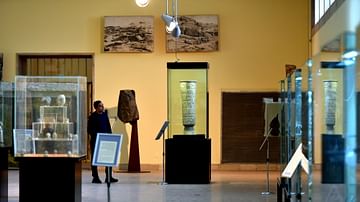Illustration
The Vase of Warka (also called Uruk Vase) is one of the earliest surviving examples of narrative art. It was excavated (in fragments) by a German excavation team in a temple complex dedicated to the goddess Inanna at the city of Uruk (in southern Iraq) in 1933-1934. It is about 1 meter tall. From Warka (ancient Uruk), Iraq. Jemdet Nasr Period, 3000-2900 BCE.
Iraq Museum, Baghdad.
About the Author
Cite This Work
APA Style
Amin, O. S. M. (2019, April 08). The Warka Vase. World History Encyclopedia. Retrieved from https://www.worldhistory.org/image/10393/the-warka-vase/
Chicago Style
Amin, Osama Shukir Muhammed. "The Warka Vase." World History Encyclopedia. Last modified April 08, 2019. https://www.worldhistory.org/image/10393/the-warka-vase/.
MLA Style
Amin, Osama Shukir Muhammed. "The Warka Vase." World History Encyclopedia. World History Encyclopedia, 08 Apr 2019, https://www.worldhistory.org/image/10393/the-warka-vase/. Web. 03 Jul 2025.



![Warka Vase [Bottom Register]](https://www.worldhistory.org/img/c/p/360x202/10536.jpg?v=1599153304)
![Warka Vase [Middle Register]](https://www.worldhistory.org/img/c/p/360x202/10597.jpg?v=1599154203)

![Offering to Inanna, Warka Vase [Top Register]](https://www.worldhistory.org/img/c/p/360x202/10591.jpg?v=1724658839-1724658887)
![Detail of Warka Vase [Top Register]](https://www.worldhistory.org/img/c/p/360x202/10595.jpg?v=1599154203)
![Offering Scene, Warka Vase [Top Register]](https://www.worldhistory.org/img/c/p/360x202/10594.jpg?v=1618594218)